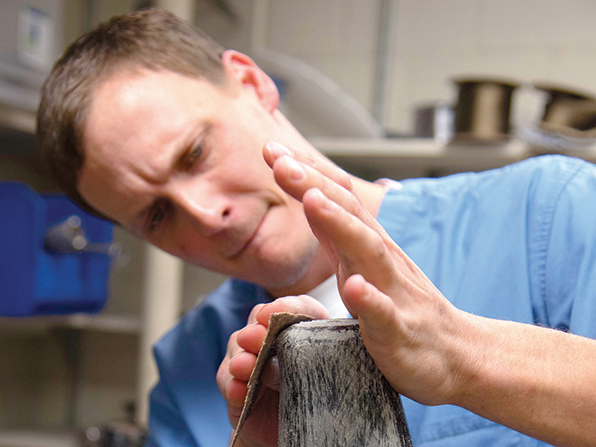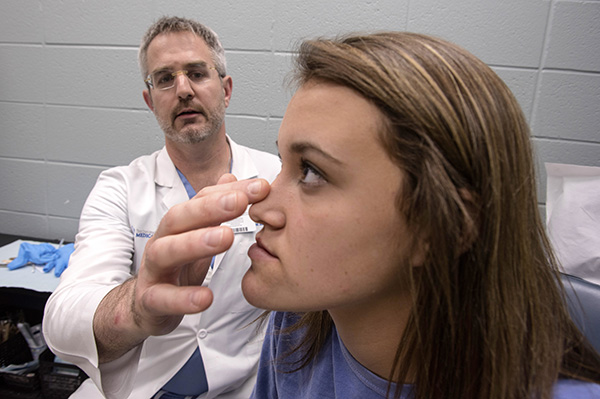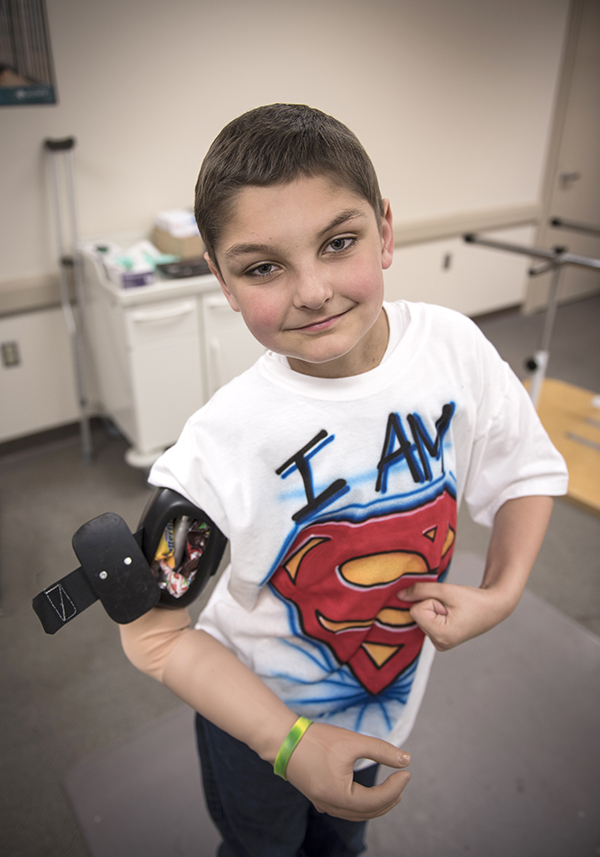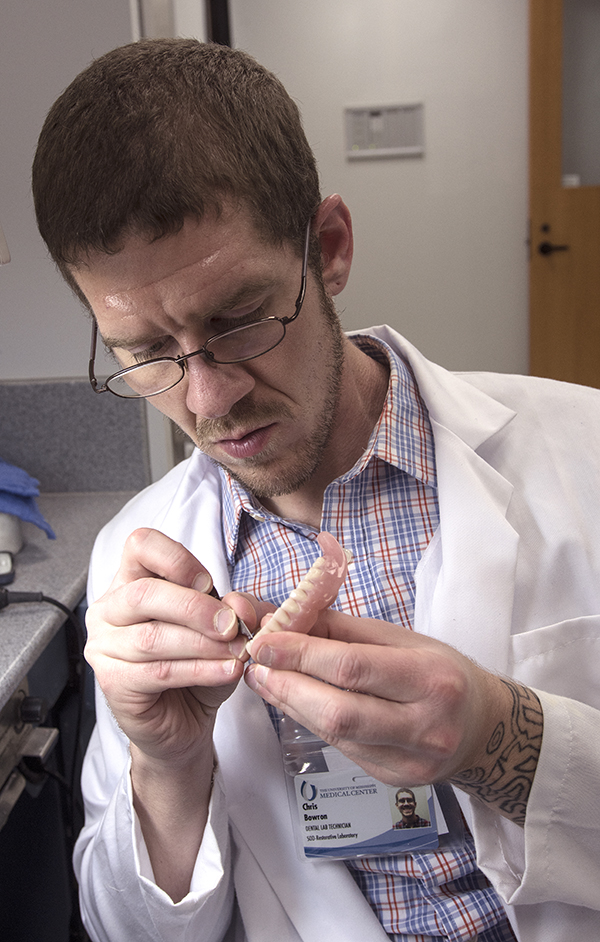Craftsmanship still holds sway as artistry in medicine

Published on February 06, 2017
In the 21st century, the term “modern medicine” evokes images of physicians and surgeons using laser beams, image-guided robotics and cybernetic implants to enhance the quality and length of life for patients.
Yet even the most state-of-the-art technological marvels run a distant second to the time-honored creativity, artistry and ingenuity of the human hand.
While the number of practitioners who rely on the latest medical gadgets continues to climb, there remains a robust fraternity of health-care
providers who take pride in the matchless artisanry of the distinct services they offer.
The following stories highlight but a few of the many true craftsmen who have perfected the art of medicine at the University of Mississippi Medical Center.
The art of oral and maxillofacial surgery

Caloss examines Cook’s face prior to surgery.
By Annie Oeth
Some works of art are framed in museums or placed on pedestals.
The artistry of the oral and maxillofacial surgeons at UMMC, though, is on display every day in the faces of those who have corrective jaw surgery to treat facial deformities that cause pain, functional impairment and facial imbalance.
“There's definitely an artistic component to the procedures we perform for patients with dentofacial deformities,” said Dr. Ron Caloss, associate professor of oral and maxillofacial surgery. “The treatment objectives for creating facial balance stem from the work of Leonardo da Vinci on human proportions.”
The artist who gave the world the Mona Lisa is helping give patients like Savannah Cook not only the ability to improve chewing, but also to feel more comfortable with her appearance and smile.
Cook, a high school freshman from Independence, said she wants to bite into hot wings, a treat she hasn't been able to enjoy because of a chewing problem that stems from a severe underbite. Just as da Vinci would have done, Caloss and his team perform a detailed analysis of the facial proportions to decide how to reposition skeletal and soft tissues.
The study of facial proportions has gone from sketches by candlelight to virtual surgery, where the artistry happens, Caloss said. His team of residents transfer patient data - including CT scans and dental models - to biomedical engineers at 3D Systems Healthcare in Littleton, Colorado.
The engineers create a virtual model of the patient's facial anatomy. This computerized model can then be manipulated to simulate surgical moves that will achieve a normal occlusion and improved facial esthetics.
“In a web meeting, we perform the entire surgery virtually on the 3-D patient model with our engineering colleagues,” Caloss said. “We create virtual osteotomies in the maxilla (upper jaw) and mandible (lower jaw) and then move them to achieve functional improvements in the upper airway, temporomandibular joints (TMJ), and occlusion of teeth.”
The surgical planning is transferred to the operating room by fabricating CAD-CAM surgical guides. Virtual planning also simulates the soft tissue profile changes that will occur.
“The artistry comes into play as your mind envisions the resulting facial changes that will occur to improve balance and proportion,” he said. “Even though corrective jaw surgery is high-tech, there is still an artistic component that is involved.”
Cook also likes the idea that form can make for better function - so much so that the straight-A student would like to become an orthodontist one day.
“I want to tell patients what I've been through and use that experience to help others.” The detailed planning culminated in her surgery on Dec. 28. 2016.
The art of orthotics and prosthetics

Josh Sexton proudly displays his new arm/candy dispenser.
By Ruth Cummins
When a little boy who lost his arm to disease asked for a mechanical replacement that can double as a candy dispenser, Blake Carr made him a sweet one.
Carr, a certified prosthetics assistant at University Orthotics and Prosthetics, used his artistic talents to craft a special drawer where Josh Sexton's bicep lies.
“It's storage for whatever candy he wants to put in there,” Carr said. “It opens and closes, and he can actually store anything there.”
The drawer is just one example of Carr's creativity when it comes to unusual requests for prosthetic limbs, including those for patients whose needs don't conform to braces you'd take off the shelf. During eight years at UMMC, Carr has made the transition to artificial limbs easier for patients because he researches their individual needs and delivers not just functional devices, but creations that reflect their personality or whims.
Sexton, an active 8-year-old from Florence, requested the compartment “so he could sneak candy into class,” his mother, Alishia Sexton, said with a laugh.
Using T-shirts that bear images from Spider-Man to Harley-Davidson motorcycles, Carr employs a resin mix to attach the shirts to prosthetic limbs
when requested.
“We do a lot of research, and we're constantly tweaking braces and coming up with new concepts,” he said. “We look at things other people have done and branch off their ideas.
“There's a lot of artistic stuff that patients don't get to see, or don't notice.”
Carr's technical skills get an extra workout with patients whose amputations aren't routine.
“We had an elderly patient whose leg was amputated, and the alignment was different,” he said. “It was so extreme that we had to make a special socket for her to use. You have to get plaster and start making examples, and the first example might not work.”
Carr fine-tunes his own device, which he constructed in his department's lab after his right leg was amputated below the knee in the wake of a four-wheeler accident. His new leg allows him maximum movement and the flexibility he needs to hunt, fish and play baseball.
On average, his department crafts five to six prosthetic devices a week - a heavy load for the Jackson metro area, Carr said.
“You're trying to slowly tweak it for the patient, and find out what is best for them,” Carr said.
The art of care planning and restorative dentistry

Bowron crafts a dental prostheses.
By Alana Bowman
Realism or naturalism in art involves the representation of daily life as we experience it, in all its mundane glory. The artist seeks to perfectly imitate the scenes that play out before him.
The fourth-floor restorative instruction lab is where realism takes place in the School of Dentistry. Lab technicians and students, under the leadership of Inge Knight, instructor in care planning and restorative dentistry, hone their skills of imitating nature.
Knight said she sees their work as more of a craft than art.
“It has to have function,” she said. “It has to blend. We have to be a little bit particular because we are trying to copy nature.”
Losing one's teeth is not only detrimental to health, it can be a blow to a person's self-esteem as well. Having a well-made set of natural-looking dentures or realistic crowns or bridges can lighten the ill effects of edentulism.
But function isn't all about the look of the replacement. Replacement teeth have to be strong as well as attractive.
The human bite has been known to exert up to 975 pounds of force, an extreme case published in 1986 by the University of Florida. On average, incisors have a force of 55 pounds, molars around 200 pounds.
Jeffrey Dickerson, a senior dental lab technician in the restorative laboratory who has been with the School of Dentistry for eight years, specializes in crowns, bridges, implants and veneers.
He said the career was suggested to him by a friend who knew he liked to draw.
“I had a friend working at a dental lab in Pearl,” Dickerson said.
“He said, 'You should come apply. You're an artistic guy.'
“They hired me that day, and I stuck with it because I love the artistic aspect of it.”
The artistic background is a common thread with denture technicians Kristen Smith and Chris Bowron as well. Smith's father was an art teacher, and she enjoys painting pottery. Bowron studied the arts throughout middle school, high school and college, graduating from Jackson State University with a fine arts degree. He is the newest member of the team and was formerly an anaplastologist, creating lifelike prostheses for upper and lower extremities out of silicone.
These artists work in wax, porcelain and acrylic, sculpting miniature statues to be displayed, possibly, in a mouth near you.
The art of laparoscopic surgery

Mayes instructs Taryn Green, M4, on his device, while Kim Zachow, M3, observes.
By Gary Pettus
Dr. Chadwick Mayes' laparoscopic trainer may not win any design awards, but as a model of thriftiness it's a picture no artist can paint.
Mayes, simulation center coordinator, built it to provide another hands-on activity for visitors - often high school and college students - to the Simulation and Interprofessional Education Center in the Classroom Wing. Medical students, especially aspiring surgeons, have taken a shine to it, too, he said.
The trainer helps hone skills required of laparoscopic, or minimally invasive, surgery, which exploits a video camera and thin instruments for operations performed through small incisions in the patient's body.
It's an exercise in dexterity that's suited to today's technologically savvy generation.
“To spark interest with the kids, I tell them that they're learning how to move in a 3-D field, but in two dimensions,” Mayes said. “If they ask me what that means, I say, 'basically, you're playing a video game.'”
But Mayes' “homemade” trainer simulates a high-tech drill with mostly low-tech materials: Velcro, balsa wood, a plastic storage container, a light bar and test tube caps. For a touch of sophisticated allure, there's a webcam.
Mayes drilled holes in the test tube caps and speared each on one of the pegs arrayed inside the trainer's container.
“You need to have some shop class in you to build it,” he said, “but it's not that hard to make.”
To relocate the caps, the operator wields a pair of long-stemmed surgical implements called graspers, which resemble a cross between a sabre and pair of scissors or a glue gun.
“The end of your instrument is about a foot ahead of your hands,” Mayes said.
The simulated surgeon's view of the operation is displayed on a computer screen, via the embedded webcam.
Dr. Gerald McKinney, associate professor of surgery, supplied the graspers. The commission to build the trainer came from Dr. Michael Holder Jr., associate professor of pediatric emergency medicine and executive director of simulation and interprofessional education.
Cutting-edge trainers can cost several thousand dollars, but Mayes said his came in at around $75 or less.
“You get the same kind of feedback, but, of course, you can't take a gallbladder out with mine,” he said.


